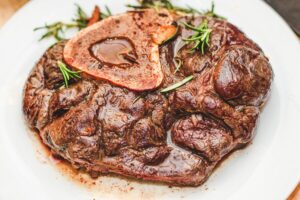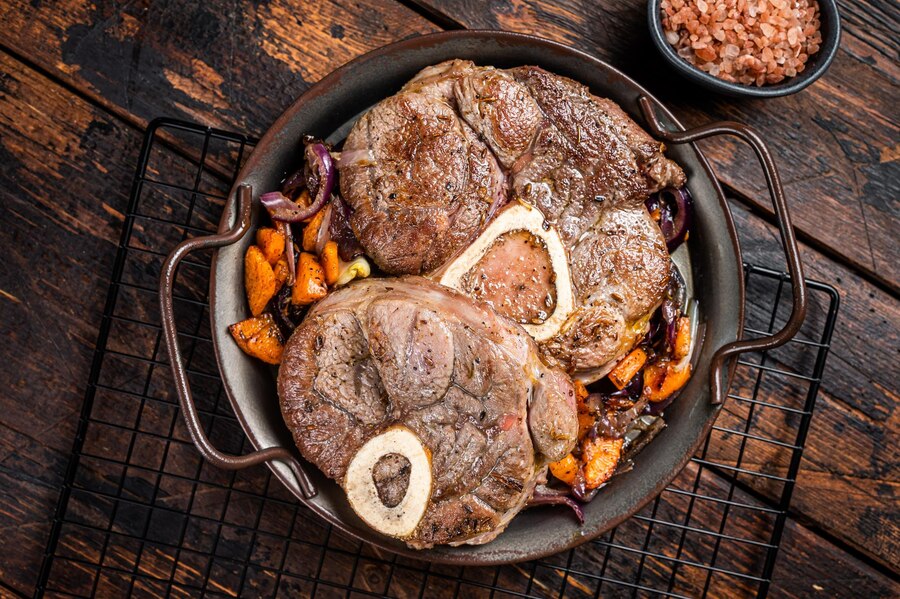When it comes to cooking beef, there are numerous cuts that chefs, home cooks, and food enthusiasts experiment with. While classic cuts like ribeye or sirloin are well-known for their tenderness and ease of cooking, less popular cuts like the beef shank often raise questions. A common query is, “Can beef shank be cooked like steak?”
Although at first glance, beef shank may look like it can be grilled or pan-seared like your favorite steak, the truth is much more complex. This article will explain everything you need to know about beef shank, why it’s not ideal for quick cooking, and how you can transform this tough cut into a tender, mouthwatering dish using the right techniques.
We’ll also look into the nutritional benefits of beef shank, various cooking methods, popular recipes, and answer some frequently asked questions, giving you the ultimate guide to beef shank cooking.
What Is Beef Shank ?
Beef shank is a cut taken from the legs of a cow, specifically the shin or lower leg. These muscles work tirelessly during the cow’s life, which is why beef shank is packed with dense muscle fibers and a lot of connective tissue. This heavy use makes the meat tougher compared to more delicate cuts like filet mignon or strip steak.
The presence of a high amount of collagen in the shank gives it a unique character. When cooked properly, the collagen breaks down into gelatin, adding a rich and flavorful dimension to the meat. However, this same collagen also means that beef shank requires slow cooking to soften and become edible.
Beef Shank Nutrition
In addition to being flavorful, beef shank is also nutritious. It is rich in protein, low in fat compared to other cuts, and offers a good source of essential vitamins and minerals such as iron, zinc, and vitamin B12. If you’re seeking a healthy yet rich source of protein, beef shank is an excellent option.
Key Nutritional Values of Beef Shank (per 100g):
- Calories: 180 kcal
- Protein: 28g
- Fat: 7g
- Iron: 15% of the daily value
- Zinc: 30% of the daily value
- Vitamin B12: 70% of the daily value
Beef Shank vs. Traditional Steak Cuts
Many popular steak cuts like ribeye, sirloin, and tenderloin come from muscles that don’t work as hard as the shank. As a result, these cuts are naturally tender and ideal for quick-cooking methods like grilling or pan-searing.
In contrast, the cow uses its shank muscles extensively, which packs the beef shank with tough connective tissues. When cooked incorrectly (such as grilling or frying), the shank remains chewy and unpleasant to eat. This is why most recipes for beef shank focus on slow cooking techniques that allow the collagen to melt, tenderizing the meat and infusing it with flavor.
How Beef Shank Differs from Steak Cuts
- Muscle Usage: Shank muscles are heavily used, which makes them tough.
- Fat Content: Shank is leaner, with less fat than steaks like ribeye or New York strip.
- Cooking Methods: Steak cuts are suited for high-heat grilling or searing, while shank benefits from slow, moist cooking like braising.
- Texture: Cooked like steak, beef shank will remain tough and chewy, unlike the soft, tender experience you get from a ribeye.
Why You Shouldn’t Cook Beef Shank Like Steak ?

If you’ve ever considered tossing a beef shank on the grill or searing it in a hot pan like you would with a sirloin, think again. The dense muscle fibers and connective tissue in the shank don’t break down easily with quick, high-heat cooking. Instead of the tender, juicy experience you get from traditional steak cuts, a beef shank will be tough, chewy, and difficult to cut through.
The Science Behind Why Shank is Tough
Collagen, the primary connective tissue in beef shank, is the key reason why this cut requires a different cooking approach. When exposed to high heat, collagen tightens and becomes even tougher. However, with long, slow cooking at low temperatures, collagen breaks down into gelatin, which gives the meat a melt-in-your-mouth texture and creates a rich, flavorful broth.
Quick Cooking Effects on Beef Shank:
- Toughens the fibers: Rapid cooking methods like grilling cause the muscle fibers to contract, making the meat tougher.
- Insufficient breakdown of collagen: Without enough time, the collagen remains intact, leading to a chewy and unpleasant texture.
How to Properly Cook Beef Shank: The Art of Braising ?
While beef shank isn’t a steak substitute, it excels in dishes that require low-and-slow cooking. The most effective method for cooking beef shank is braising. This involves cooking the meat slowly in a liquid, allowing the collagen to break down and the meat to become tender.
Step-by-Step Guide to Braising Beef Shank
- Preheat and Prep: Preheat your oven to 275°F (135°C) or prepare your slow cooker.
- Sear the Shank: In a heavy-bottomed pan, sear the beef shank on all sides in olive oil. This caramelizes the surface, enhancing the flavor.
- Add Aromatics: Remove the beef and sauté garlic, onions, and any herbs you prefer (rosemary, thyme, bay leaves).
- Deglaze the Pan: Add wine, broth, or tomato paste to the pan to scrape up the browned bits stuck to the bottom, adding extra flavor.
- Slow Cook: Return the shank to the pot, cover it with liquid (broth, wine, or tomatoes), and braise in the oven for 3–4 hours or in a slow cooker for 6–8 hours until the meat is tender and falling off the bone.
- Rest and Serve: Once the meat is done, let it rest for 10–15 minutes before serving with your choice of side dishes like mashed potatoes or risotto.
Variations of Beef Shank Recipes
- Osso Buco: A traditional Italian dish made with braised beef shank, typically served over risotto or mashed potatoes. The marrow from the bone also adds a depth of flavor.
- Beef Shank Stew: A hearty, slow-cooked stew filled with vegetables like carrots, celery, and potatoes.
- Shredded Beef Shank Tacos: Once the beef shank is slow-cooked, it can be shredded and used in tacos or sandwiches, similar to pulled pork.
Creative Uses for Beef Shank in Cooking.
Though beef shank can’t be quickly seared or grilled, its versatility shines when slow-cooked. Here are several creative ways to use slow-cooked beef shank in delicious dishes:
1. Stews and Soups
Due to its richness, beef shank is perfect for stews and soups, especially those with a long cooking time. When slow-cooked, the collagen transforms into gelatin, enriching the broth. Popular dishes include beef shank and vegetable stew or bone broth made from the shank’s marrow.
2. Pulled Beef Shank
Slow-cooked beef shank can be shredded, just like pulled pork. You can use it for beef tacos, sandwiches, or even mixed into pasta for a unique twist.
3. Bone Marrow Dishes
The bone in the beef shank contains rich bone marrow, which you can extract after cooking. You can use it as a flavorful spread or incorporate it into sauces for added richness.
4. Osso Buco
Perhaps the most famous dish using beef shank, Osso Buco is a braised shank that originated in Italy. Typically, you cook the shank in wine, broth, and herbs, then serve it over risotto or polenta. You often enjoy the marrow inside the bone as part of the meal.
5. Shank-Based Bone Broth
The bones from a beef shank are perfect for making nutrient-rich bone broth. You can consume this broth on its own or use it as a base for soups, sauces, and stews. People highly value bone broth for its collagen content, which promotes joint health and aids digestion.
Common Mistakes When Cooking Beef Shank.
While slow cooking transforms beef shank into a tender delicacy, there are some common mistakes that can ruin your dish:
1. Not Cooking Long Enough
Rushing the process is the most common mistake. Beef shank needs time—lots of it. Even in a slow cooker, it’s not uncommon to cook shank for 6–8 hours to break down the collagen properly.
2. Not Enough Liquid
Braising requires liquid to keep the meat moist during cooking. Be sure to cover at least half of the beef shank with broth or another liquid while braising.
3. Skipping the Sear
Searing the meat before braising helps lock in the flavor and provides a richer final dish. Don’t skip this step!
4. Overcrowding the Pan
If you’re braising multiple shanks, make sure they’re not packed too tightly. Overcrowding leads to steaming instead of proper browning, which affects the flavor and texture.
FAQs.
Can Beef Shank Be Grilled?
Avoid grilling beef shank because the high heat tightens the collagen and connective tissue, which makes the meat tough. Stick to slow, moist cooking methods like braising for the best results.
How Long Should I Cook Beef Shank?
Cook beef shank for at least 3–4 hours when braising or slow-cooking. In a pressure cooker, reduce the cooking time to around 1–1.5 hours.
Is Beef Shank Nutritious?
Yes! Beef shank is an excellent source of protein and collagen and contains essential nutrients like iron, zinc, and vitamin B12. It has less fat than other cuts of beef, which makes it a healthy option when you cook it properly.
Can You Cook Beef Shank in a Slow Cooker?
Yes, beef shank is ideal for slow cooker recipes. The slow cooker allows the collagen to break down over several hours, resulting in tender, flavorful meat.
Conclusion: Can beef shank be cooked like steak ?
Although beef shank may look like a steak, it offers a completely different cut of meat that requires slow cooking to unlock its full potential.. The dense fibers and high collagen content make it tough when cooked quickly, but with the right method whether it’s braising, stewing, or slow-cooking beef shank becomes a rich and flavorful centerpiece for a variety of dishes.
Rather than viewing beef shank as a steak alternative, see it as an opportunity to experiment with deeper, richer flavors that only long, slow cooking can achieve. When treated right, this humble cut can become a star in your kitchen.
By following these guidelines, you can ensure that your beef shank dishes are tender, flavorful, and deeply satisfying.

